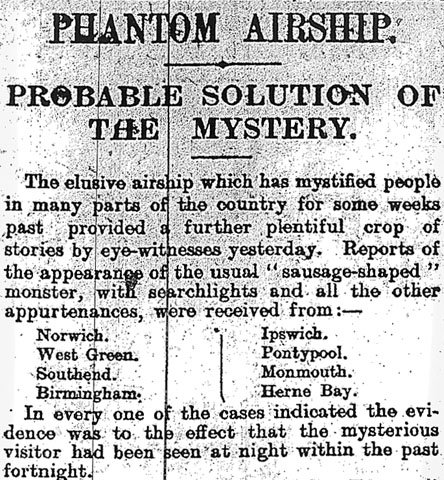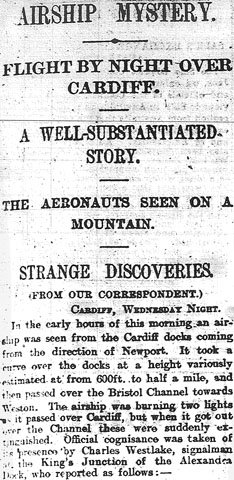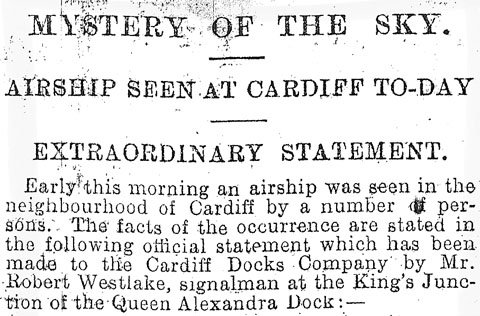The Standard again has an article (p. 8) on the 'mysterious airship', though this time the information is taken from today's Daily Express. The Berlin correspondent of that paper has been making inquiries there, and reports that
German expert opinion is unanimous in believing that the airship ascends from some German warship in the North Sea, upon which it lands again after each of its flights.
The German navy is, as it happens, conducting exercises in the North Sea, and relatively small airships of the Gross or Parseval types could possibly be inflated and launched from a warship. But although the German navy is known to have ordered these smaller airships, it's unclear whether it actually has any yet.
The Norfolk News has a report on the activity of the phantom airship, or as the headline on page 15 has it, the 'phanton airship'. Disappointingly, although the Norfolk News is bang in the middle of scareship territory, it seems to be relying on the reports of London newspapers (again, the Daily Express). Accounts from three eyewitnesses are given. The first is the brother-in-law of Herbert Neaverson, a 'prominent Peterborough tradesman', who has made a statement to the War Office in London. He heard 'a swishing sound overhead and the throbbing of a motor' early in the morning at his home in Peakirk. He looked up and saw a 'peculiar light' coming from the direction of the sea. At Kingscliff, Great Clacton, one Mr Egerton Free saw 'an oblong machine hovering quite near my home' at dusk, ten days ago. It was 'stationary' for a few minutes and then disappeared in the direction of Frinton. Finally, Miss H. M. Bonville of Southend-on-Sea saw the 'fly by night' last Sunday, at about 11.20pm. Her description is similar to that of Free: it was 'a large, black object, oblong in shape'. Initially stationary, it suddenly rose in the air and headed in the direction of London, briefly showing 'a couple of very brilliant lights'.
The Norfolk News also adds that
A search for the airship's home is being undertaken by motorists and others in all parts of East Anglia.
If the warship theory is correct, then they won't find anything, of course. But this amateur sleuthing connects the phantom airship scare with the spy mania also prevalent at this time. Indeed, The Times carries several letters relating to the Legion of Frontiersmen, an unofficial patriotic organisation which at times indulges in the sport of spyhunting. More intriguingly, immediately following its 'mysterious airship' article, the Standard has a report of 'several suspicious movements of strangers' near an Admiralty telegraph station at Humberstone, near Grimsby (and so also on the east coast), leading to 'elaborate precautions'.
One of the staff of the station, it is stated [by a correspondent], was recently attacked and rendered unconscious by two men who sprang on him from behind and afterwards escaped [...] locally there appears to be the impression that the outrage was the work of foreign spies bent on obtaining an entrance to the room where the code-book is kept.
The current success of Major Guy du Maurier's play An Englishman's Home, about an invasion of England by 'Nearland', probably doesn't do much to sooth fears. Today's Southampton Times and Hampshire Express has a puff piece (p. 9) about its upcoming Southampton run ('It should be seen by all -- men and women -- not only for the great and valuable lesson it teaches, but also because it is a powerful, real, and interesting play'): on the first night's performance recruiting officers will be present for the Territorial Army. The Norfolk News also mentions (p. 8) the play: a speaker at a Norwich meeting of the Peace Society objecting to the military's use of 'every means to entrap the young fellows of our country' notes that:
Even whilst we are at this meeting a play is being introduced at our local theatre, the object of which is to show by a very much overdrawn production how needful it is to be prepared against an enemy that does not exist.
On the other hand, the Globe relates (p. 2) an amusing anecdote given by Major Baden Baden-Powell (brother of B-P, and an expert in military ballooning, as it happens) at the annual dinner of the Iron and Steel Institute. Baden-Powell referred to the 'stories of certain nations being ready to invade these shores, how they had plans laid down, and spies swarming in this country watching details'. He himself asked an officer from a 'certain army' [i.e. Germany's] whether this was true:
The officer told him that that was so, and that they had details of the Eastern counties, every village was marked, the principal landowners and officials were known, and even the postmasters of the villages were recorded. "How did you get it?" he asked, and the officer replied, "We spent 10s. 6d. and bought a Kelly's County Directory" (loud laughter). So much for spies (hear, hear, and laughter).
This shows that not everyone bought into the spy scare. But that the anecdote was worthy of telling and got such a big reaction also suggests that there were plenty who did.




